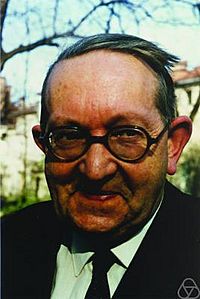Harold Davenport facts for kids
Quick facts for kids
Harold Davenport
|
|
|---|---|

Davenport in 1968
|
|
| Born | 30 October 1907 Huncoat, Lancashire, England
|
| Died | 9 June 1969 (aged 61) Cambridge, England
|
| Alma mater | University of Manchester Trinity College, Cambridge |
| Known for |
|
| Children | James H. Davenport |
| Awards | Rayleigh Prize (1930) Adams Prize (1940) Senior Berwick Prize (1954) Sylvester Medal (1967) Fellow of the Royal Society |
| Scientific career | |
| Fields | Number theory |
| Institutions | University of Manchester University of Wales University College London University of Cambridge |
| Doctoral advisor | John Edensor Littlewood |
| Doctoral students | John Horton Conway Alan Baker Peter Elliott H. L. Montgomery Martin Huxley G. L. Watson |
Harold Davenport FRS (born October 30, 1907 – died June 9, 1969) was an important English mathematician. He was famous for his wide-ranging work in number theory, which is a branch of mathematics that studies whole numbers and their properties.
Contents
Early Life and Education
Harold Davenport was born in Huncoat, Lancashire, England, on October 30, 1907. He went to Accrington Grammar School for his early education.
Later, he studied at the University of Manchester, graduating in 1927. He then continued his studies at Trinity College, Cambridge. There, he became a research student of John Edensor Littlewood, another famous mathematician. Davenport's early research focused on how quadratic residues are spread out.
First Steps in Research
Davenport's early work led him to study complex math problems. These problems involved special kinds of equations and numbers. He looked at how certain mathematical sums behaved.
In 1932 and 1933, Davenport traveled to Germany. He worked with Helmut Hasse, an expert in a field called algebraic theory. This collaboration led to important work on the Hasse–Davenport relations. He also met Hans Heilbronn, with whom he would work later. Davenport admitted that he preferred his own methods and didn't fully explore new algebraic ideas at the time.
Later Career and Achievements
In 1937, Harold Davenport joined the School of Mathematics, University of Manchester. This was a very exciting time, as many talented mathematicians were joining the department. He started to focus on areas like diophantine approximation and geometry of numbers. These were popular topics in mathematics.
Davenport was the President of the London Mathematical Society from 1957 to 1959. After working as a professor at the University of Wales and University College London, he moved to University of Cambridge in 1958. He became the Rouse Ball Chair of Mathematics, a very respected position. He stayed in Cambridge until he passed away from lung cancer.
Personal Life
Harold Davenport married Anne Lofthouse in 1944. They met at the University College of North Wales at Bangor. They had two children, Richard and James. James also became a professor, teaching Information Technology at the University of Bath.
His Impact on Mathematics
From around 1950, Davenport became a clear leader in the field of mathematics in Britain. He led a "school" of thought focused on number theory, especially the analytical side. This meant solving problems using strong mathematical methods.
His approach encouraged mathematicians to tackle difficult problems directly. He believed in finding out "how big or small" numbers and mathematical objects could be. This practical way of thinking was different from some other abstract mathematical ideas popular at the time. His work greatly influenced later mathematicians, including his students like Alan Baker.
Books by Harold Davenport
- The Higher Arithmetic: An Introduction to the Theory of Numbers (1952)
- Multiplicative number theory (1967)
- A second edition was later revised by Hugh L. Montgomery.
- The collected works of Harold Davenport (1977) in four volumes, edited by B. J. Birch, H. Halberstam, and C. A. Rogers.

